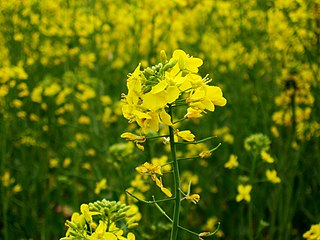
Genetic engineering, also called genetic modification or genetic manipulation, is the modification and manipulation of an organism's genes using technology. It is a set of technologies used to change the genetic makeup of cells, including the transfer of genes within and across species boundaries to produce improved or novel organisms.

Rice is a cereal grain, and in its domesticated form is the staple food for over half of the world's human population, particularly in Asia and Africa, due to the vast amount of soil that is able to grow rice. Rice is the seed of the grass species Oryza sativa or, much less commonly, O. glaberrima. Asian rice was domesticated in China some 13,500 to 8,200 years ago, while African rice was domesticated in Africa some 3,000 years ago. Rice has become commonplace in many cultures worldwide; in 2021, 787 million tons were produced, placing it fourth after sugarcane, maize, and wheat. Only some 8% of rice is traded internationally. China, India, and Indonesia are the largest consumers of rice. A substantial amount of the rice produced in developing nations is lost after harvest through factors such as poor transport and storage. Rice yields can be reduced by pests including insects, rodents, and birds, as well as by weeds, and by diseases such as rice blast. Traditional polycultures such as rice-duck farming, and modern integrated pest management seek to control damage from pests in a sustainable way.

A homeobox is a DNA sequence, around 180 base pairs long, that regulates large-scale anatomical features in the early stages of embryonic development. Mutations in a homeobox may change large-scale anatomical features of the full-grown organism.

Phytochromes are a class of photoreceptor proteins found in plants, bacteria and fungi. They respond to light in the red and far-red regions of the visible spectrum and can be classed as either Type I, which are activated by far-red light, or Type II that are activated by red light. Recent advances have suggested that phytochromes also act as temperature sensors, as warmer temperatures enhance their de-activation. All of these factors contribute to the plant's ability to germinate.
In developmental biology, photomorphogenesis is light-mediated development, where plant growth patterns respond to the light spectrum. This is a completely separate process from photosynthesis where light is used as a source of energy. Phytochromes, cryptochromes, and phototropins are photochromic sensory receptors that restrict the photomorphogenic effect of light to the UV-A, UV-B, blue, and red portions of the electromagnetic spectrum.
Shade avoidance is a set of responses that plants display when they are subjected to the shade of another plant. It often includes elongation, altered flowering time, increased apical dominance and altered partitioning of resources. This set of responses is collectively called the shade-avoidance syndrome (SAS).
The repressilator is a genetic regulatory network consisting of at least one feedback loop with at least three genes, each expressing a protein that represses the next gene in the loop. In biological research, repressilators have been used to build cellular models and understand cell function. There are both artificial and naturally-occurring repressilators. Recently, the naturally-occurring repressilator clock gene circuit in Arabidopsis thaliana and mammalian systems have been studied.
Khanna is a Khatri clan of the Dhai Ghar community found in Punjabi Hindu communities. Individuals belonging to the clan commonly bear 'Khanna' as their family name or surname.

ID4 is a protein coding gene. In humans, it encodes for the protein known as DNA-binding protein inhibitor ID-4. This protein is known to be involved in the regulation of many cellular processes during both prenatal development and tumorigenesis. This is inclusive of embryonic cellular growth, senescence, cellular differentiation, apoptosis, and as an oncogene in angiogenesis.

Single-minded homolog 1, also known as class E basic helix-loop-helix protein 14 (bHLHe14), is a protein that in humans is encoded by the SIM1 gene.

Achaete-scute complex homolog 2 (Drosophila), also known as ASCL2, is an imprinted human gene.

60S ribosomal protein L41 is a protein that is specific to humans and is encoded by the RPL41 gene, also known as HG12 and large eukaryotic ribosomal subunit protein eL41. The gene family HGNC is L ribosomal proteins. The protein itself is also described as P62945-RL41_HUMAN on the GeneCards database. This RPL41 gene is located on chromosome 12.

In biology, phototropism is the growth of an organism in response to a light stimulus. Phototropism is most often observed in plants, but can also occur in other organisms such as fungi. The cells on the plant that are farthest from the light contain a hormone called auxin that reacts when phototropism occurs. This causes the plant to have elongated cells on the furthest side from the light. Phototropism is one of the many plant tropisms, or movements, which respond to external stimuli. Growth towards a light source is called positive phototropism, while growth away from light is called negative phototropism. Negative phototropism is not to be confused with skototropism, which is defined as the growth towards darkness, whereas negative phototropism can refer to either the growth away from a light source or towards the darkness. Most plant shoots exhibit positive phototropism, and rearrange their chloroplasts in the leaves to maximize photosynthetic energy and promote growth. Some vine shoot tips exhibit negative phototropism, which allows them to grow towards dark, solid objects and climb them. The combination of phototropism and gravitropism allow plants to grow in the correct direction.

Ulrich Kutschera is a former German professor of biology who works as an academic advisor at I-Cultiver, Inc. in San Francisco and as a visiting scientist in Stanford/Palo Alto, California, US. He is the founder and head of "AK Evolutionbiologie", an association of evolutionary biologists in Germany. Starting in the 2000s, Kutschera started engaging with the public, first as a critic of creationism and intelligent design. Since the mid-2010s, his public statements and popular books focused on climate skepticism and criticism of gender studies.
LUX or Phytoclock1 (PCL1) is a gene that codes for LUX ARRHYTHMO, a protein necessary for circadian rhythms in Arabidopsis thaliana. LUX protein associates with Early Flowering 3 (ELF3) and Early Flowering 4 (ELF4) to form the Evening Complex (EC), a core component of the Arabidopsis repressilator model of the plant circadian clock. The LUX protein functions as a transcription factor that negatively regulates Pseudo-Response Regulator 9 (PRR9), a core gene of the Midday Complex, another component of the Arabidopsis repressilator model. LUX is also associated with circadian control of hypocotyl growth factor genes PHYTOCHROME INTERACTING FACTOR 4 (PIF4) and PHYTOCHROME INTERACTING FACTOR 5 (PIF5).

Dhara Mustard Hybrid-11, otherwise known as DMH - 11, is a genetically modified hybrid variety of the mustard species Brassica juncea. It was developed by Professor Deepak Pental from the University of Delhi, with the aim of reducing India's demand for edible oil imports. DMH - 11 was created through transgenic technology, primarily involving the Bar, Barnase and Barstar gene system. The Barnase gene confers male sterility, while the Barstar gene restores DMH - 11's ability to produce fertile seeds. The insertion of the third gene Bar, enables DMH - 11 to produce phosphinothricin-N- acetyl-transferase, the enzyme responsible for Glufosinate resistance. This hybrid mustard variety has come under intense public scrutiny, mainly due to concerns regarding DMH - 11's potential to adversely affect the environment as well as consumer health. DMH - 11 was found not to pose any food allergy risks, and has demonstrated increased yields over existing mustard varieties. Conflicting details and results regarding the field trials and safety evaluations conducted on DMH - 11 have delayed its approval for commercial cropping.
Dmitri Nusinow is an American chronobiologist who studies plant circadian rhythms. He was born on November 7, 1976, in Inglewood, California. He currently resides in St. Louis, and his research focus includes a combination of molecular, biochemical, genetic, genomic, and proteomic tools to discover the molecular connections between signaling networks, circadian oscillators, and specific outputs. By combining these methods, he hopes to apply the knowledge elucidated from the Arabidopsis model to other plant species.

Biliproteins are pigment protein compounds that are located in photosynthesising organisms such as algae, and sometimes also in certain insects. They refer to any protein that contains a bilin chromophore. In plants and algae, the main function of biliproteins is to make the process of light accumulation required for photosynthesis more efficient; while in insects they play a role in growth and development. Some of their properties: including light-receptivity, light-harvesting and fluorescence have made them suitable for applications in bioimaging and as indicators; while other properties such as anti-oxidation, anti-aging and anti-inflammation in phycobiliproteins have given them potential for use in medicine, cosmetics and food technology. While research on biliproteins dates back as far as 1950, it was hindered due to issues regarding biliprotein structure, lack of methods available for isolating individual biliprotein components, as well as limited information on lyase reactions . Research on biliproteins has also been primarily focused on phycobiliproteins; but advances in technology and methodology, along with the discovery of different types of lyases, has renewed interest in biliprotein research, allowing new opportunities for investigating biliprotein processes such as assembly/disassembly and protein folding.
Doris Wagner is an American biologist who is the Robert I. Williams Term Professor of Biology at the University of Pennsylvania. Her research looks to better understand the structure-function relationships of plant cells. She established the Epigenomics of Plants International Consortium. Wagner is a Fellow of the American Society of Plant Biologists.
Elaine Munsey Tobin is a professor of molecular, cell, and developmental biology at the University of California, Los Angeles (UCLA). Tobin is recognized as a Pioneer Member of the American Society of Plant Biologists (ASPB).











